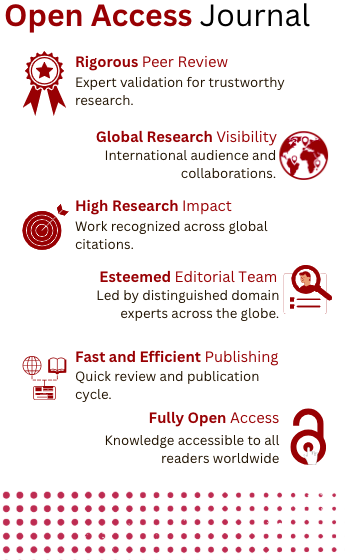An Approach to Find Optimal Locations for Base Station to Achieve Energy Efficiency in Wireless Sensors Network
DOI:
https://doi.org/10.5281/zenodo.10628289Keywords:
Cluster, Multiple Base Stations, Network Life- time, Relocation, Uneven Distribution, Wireless SensorsAbstract
Due to the difficulty of recharging the batteries of Sensor Nodes (SNs), which have a finite amount of energyresources, energy efficiency is one of the crucial factors to take into account in Wireless Sensor Networks (WSNs). Base Station (BS) location in WSN plays a significant role as it is one of the deciding factor on network performance. Byplacing the BS at optimal location, it can increase the WSN’s energy efficiency and network coverage. Placement of theBS at optimal location is complex problem and it requires balance between coverage of the network and energy efficiency. In this work we have used Low Energy Adaptive Clustering Hierarchy (LEACH) protocol as routingalgorithm. We placed BS at the center of each of the quadrant of square shaped deployment area as well as at thecenter of entire deployment area. We evaluated network longevity as a measure of performance, and we observed how much energy was used for each round. Results indicate that location of the BS is optimal if the placement of BSconnects the farthest SN with shorter distance until First Node Dies (FND), stays near where there are more number of SNs situated until Half Node Dies (HND) and at the center of the deployment area in our case until Last Node Dies(LND) compared with other locations.
References
Heinzelman, W. B. (2002). An Application-Specific Protocol Architecture for Wireless Microsensor Networks. IEEE TRANSACTIONS ON WIRELESS COMMUNICATIONS google schola,
Akkaya, K., Younis, M., & Youssef, W. (2007). Positioning of base stations in wireless sensor networks. IEEE Communications Magazine, 45(4), 96-102.
Pan, J., Cai, L., Hou, Y. T., Shi, Y., & Shen, S. X. (2005). Optimal base-station locations in two-tiered wireless sensor networks. IEEE Transactions on Mobile Computing, 4(5), 458-473.
Li, X., Cai, H., Liu, G., & Lu, K. (2019, December). Base Station Positioning in Single-Tiered Wireless Sensor Networks. In 2019 20th International Conference on Parallel and Distributed Computing, Applications and Technologies (PDCAT) (pp. 7-12). IEEE.
Kumar, V., & Kumar, A. (2019). Improving reporting delay and lifetime of a WSN using controlled mobile sinks. Journal of Ambient Intelligence and Humanized Computing, 10, 1433-1441.
Moh’d Alia, O. (2017). Dynamic relocation of mobile base station in wireless sensor networks using a cluster-based harmony search algorithm. Information Sciences, 385, 76-95.
Asorey-Cacheda, R., Garcia-Sanchez, A. J., García-Sánchez, F., & García-Haro, J. (2017). A survey on non-linear optimization problems in wireless sensor networks. Journal of Network and Computer Applications, 82, 1-20.
Gandham, S. R., Dawande, M., Prakash, R., & Venkatesan, S. (2003, December). Energy efficient schemes for wireless sensor networks with multiple mobile base stations. In GLOBECOM'03. IEEE Global Telecommunications Conference (IEEE Cat. No. 03CH37489) (Vol. 1, pp. 377-381). IEEE.
Veeramani, S., & Noor Mahammad, S. (2020). An approach to place sink node in a wireless sensor network (WSN). Wireless Personal Communications, 111, 1117-1127.
Khodashahi, M. H., Tashtarian, F., Moghaddam, M. H. Y., & Honary, M. T. (2010, April). Optimal location for mobile sink in wireless sensor networks. In 2010 IEEE Wireless Communication and Networking Conference (pp. 1-6). IEEE.
Tamandani, Y. K., Bokhari, M. U., & Kord, M. Z. (2017). Computing geometric median to locate the sink node with the aim of extending the lifetime of wireless sensor networks. Egyptian Informatics Journal, 18(1), 21-27.
Jain, T. K., Saini, D. S., & Bhooshan, S. V. (2015). Lifetime optimization of a multiple sink wireless sensor network through energy balancing. journal of Sensors, 2015.
Syed Thouheed Ahmed, S., Sandhya, M., & Shankar, S. (2018, August). ICT’s role in building and understanding indian telemedicine environment: A study. In Information and Communication Technology for Competitive Strategies: Proceedings of Third International Conference on ICTCS 2017 (pp. 391-397). Singapore: Springer Singapore.
Raja, D. K., Kumar, G. H., Basha, S. M., & Ahmed, S. T. (2022). Recommendations based on integrated matrix time decomposition and clustering optimization. International Journal of Performability Engineering, 18(4), 298.
Fathima, A. S., Prakesh, D., & Kumari, S. (2022). Defined Circle Friend Recommendation Policy for Growing Social Media. International Journal of Human Computations & Intelligence, 1(1), 9-12.
Ahmed, S. T., Sandhya, M., & Sankar, S. (2019). A dynamic MooM dataset processing under TelMED protocol design for QoS improvisation of telemedicine environment. Journal of medical systems, 43(8), 257.
Downloads
Published
How to Cite
Issue
Section
License
Copyright (c) 2024 Maruthi H C, Poornima G

This work is licensed under a Creative Commons Attribution-NonCommercial-NoDerivatives 4.0 International License.







